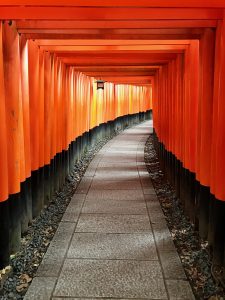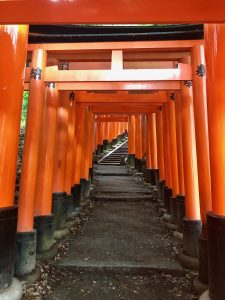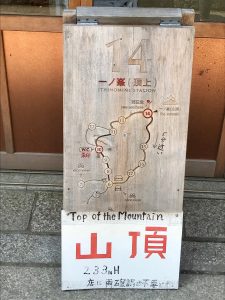The Red Gates of Fushimi Inari
Written by Sophie, November 2020
Fushimi Inari-taisha is probably one of the most well-known, and most visited, sites in Kyoto and possibly Japan. That didn’t stop me from visiting on both my trips to Kyoto. The shrine itself is spectacular, but the main attraction is the mountain path lined by thousands of torii gates.
The bright red torii gates have all been donated by families and companies and are surprisingly expensive, with the smaller gates costing approximately 400,000 yen (£2900)! Ascending to the top of the mountain takes around 1-2 hours (depending on your pace) and takes you past many smaller shrines along the way. There is one I particularly like that is overrun with statues of frogs.
Of course, the animal that is most abundant at Fushimi Inari is the fox. The fox statues represent the fox messengers of the deity Inari, and are usually depicted holding keys, scrolls or sheafs of rice in their mouths. A pair of foxes on either side of the shrine is a pretty good indicator that the shrine is to Inari. As Inari is the deity of prosperity (both in business and in general) among other things, it is hardly surprising that there are so many Inari shrines across Japan.
The first time I visited Fushimi Inari, in mid-July, I underestimated the heat as well as the steepness of some sections of the mountain trail. That time I only made it about halfway up the mountain path before turning back to seek out a cold shower and something to eat. The following year, when I found myself visiting Kyoto again, I was determined to reach the summit.
Having learned from my previous failed attempt I arrived at the shrine an hour earlier than last time, at 8:30 am. It also happened to be late June, so whilst it would get hot, I hoped it would be nowhere near as hot and humid as before. Another benefit of arriving earlier was that the shrine was less busy, a plus all around. Wearing a pair of comfortable trainers, I began the ascent. The beginning sections of the path are simply spectacular with torii gate packed so densely you can hardly see the sky above you. The higher you get, the more spread out the gates begin to get.
There are maps along the way, and certain checkpoints so you know both where you are, and how much further you have to go. At station 7, there is a great view across the whole of Kyoto. At each station there are small shops and vending machines, where you can get souvenirs and food. The shops weren’t open yet when I was visiting, however if you were climbing at a slightly more reasonable hour, I’m sure they would be. Be sure to either bring some water, or some change for the vending machine (quite brilliantly lots of vending machines in Japan will accept payment from a rail card like suica or passmo – if only I could use my oyster card like that in London!).
As we ascended higher, the number of other climbers also began to dwindle. The path began to get steeper, but there was no rush – we could take our time and enjoy the woodland surrounding us as we climbed. After an hour or so of walking, we reached the summit. We’d climbed 233m in elevation and were rewarded with another shrine (as well as an immense feeling of satisfaction!)
Once we’d enjoyed the top of the mountain – there was a shop selling t-shirts to show you’d reached the top but unfortunately it wasn’t open – and rested our legs for a bit, it was time to start the descent. Going down the mountain was far easier than going up, and I will admit to feeling slightly smug as we passed people still on their way up. Seeing the red gates from the other side also let you see the names of all the people and businesses who had donated them, and the black kanji painted on the torii gave them a different look to the smooth bright red we had experienced on our way up.
Finally, after a leisurely descent we reached the base of the mountain and the main shrine. A lot of the souvenir shops were open now, and we came away with a miniature torii gate, as well as a tiny model fox.
Fushimi Inari-taisha has earned its reputation as one of Japan’s most famous shrines for good reason. It is well worth visiting and is in fact open 24/7 – I would love to try the climb at night should I be lucky enough to return to Kyoto. No matter how far up the mountain you get, don’t forget to treat yourself to some mochi when you get back to the bottom.
Find out more here: http://inari.jp/en/




